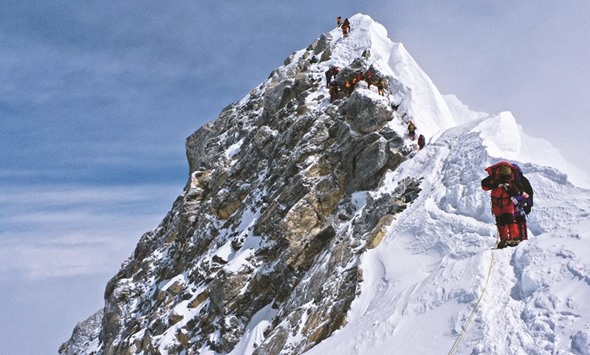Mountaineers have confirmed that a famous rocky outcrop near the peak of Mount Everest has collapsed, potentially making the climb more dangerous.
The Hillary Step, named after Sir Edmund Hillary who, along with the Sherpa Tenzing Norgay, was the first person to climb the mountain in 1953, may have been destroyed during the 2015 Nepal earthquake.
The 12m-high rocky outcrop was a nearly vertical climb on the southeast ridge of the mountain. There had been rumours from climbers on earlier expeditions that the step had been destroyed, but snowy conditions made it difficult to confirm.
The British expedition leader Tim Mosedale, who reached the summit last week, posted a photograph on Facebook and confirmed the destruction of the Hillary Step.
“It’s official – the Hillary Step is no more,” wrote Mosedale.
“It was reported last year, and indeed I climbed it last year, but we weren’t sure for certain that ‘the Step’ had gone because the area was blasted with snow. This year, however, I can report that the chunk of rock named ‘the Hillary Step’ is definitely not there any more.”
Last year reports of the step’s destruction began circulating after photographs were published by the American Himalayan Foundation. Snow cover in the pictures made it difficult to say the section had definitely collapsed.
Mosedale, who reached Everest’s summit for the sixth time on 16 May, posted a photograph of what remains of the Hillary Step when he returned to base camp after the climb. The photograph shows the topography has changed significantly compared with photographs taken a few years ago.
Located at 8,790m, the Hillary Step is a steep and narrow section considered by climbers to be the last obstacle before the summit, which is at 8,848m.
Its destruction may make the ascent easier – as it will no longer involve a vertical rock climb – or more dangerous because there may be limited paths up the section, meaning climbers will have to wait for long periods in cold temperatures and at a high altitude while others attempt it.
“It’s easier going up the snow slope and indeed for inexperienced climbers and mountaineers there’s less ‘climbing’ to be done, making it much easier for them,” Mosedale told Planet Mountain.
“However, it’s going to form a bottleneck. The Hillary Step often formed a bottleneck but some years ago they fixed an up and a down rope. In the current state it would be difficult to safely negotiate down where the step used to be on account of the huge unstable rocks that are perched on the route.”

This file photo shows climbers descending the Hillary Step on Mt Everest.
